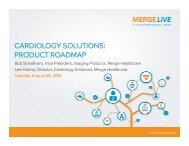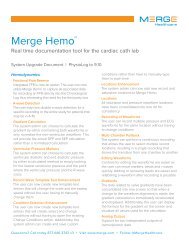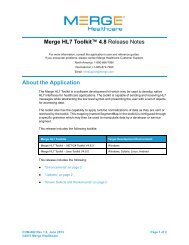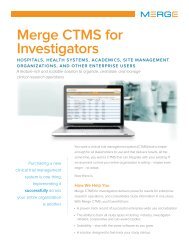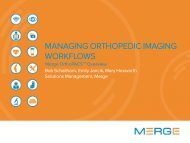Using MRI-CAD to Increase Efficiency ... - Merge Healthcare
Using MRI-CAD to Increase Efficiency ... - Merge Healthcare
Using MRI-CAD to Increase Efficiency ... - Merge Healthcare
Create successful ePaper yourself
Turn your PDF publications into a flip-book with our unique Google optimized e-Paper software.
<strong>Using</strong> <strong>MRI</strong>-<strong>CAD</strong> <strong>to</strong> <strong>Increase</strong><br />
<strong>Efficiency</strong> & Effectiveness<br />
<strong>MRI</strong> Scan & Imaging Centers | Fort Lauderdale, FL<br />
CUSTOMER PROFILE<br />
• Perform a variety of advanced<br />
services including <strong>MRI</strong> imaging,<br />
CT scans, nuclear medicine and<br />
ultrasounds<br />
• Only imaging center in Florida <strong>to</strong><br />
use a 3.0T high field <strong>MRI</strong><br />
• Medical Direc<strong>to</strong>r Dr. Robert Kagan<br />
introduced <strong>MRI</strong> <strong>to</strong> Florida, opening<br />
the first <strong>MRI</strong> facility in the state in<br />
1983 and his was the first facility <strong>to</strong><br />
receive FDA approval in April 1984<br />
CUSTOMER CHALLENGES<br />
• Time-consuming <strong>to</strong> manually<br />
process <strong>MRI</strong> data<br />
• Studies are extremely complex<br />
and involve huge amounts of data<br />
• Reimbursements for studies are<br />
declining<br />
BENEFITS<br />
• More efficient <strong>MRI</strong> study analysis<br />
and reporting<br />
• Easily expand from breast <strong>to</strong> liver<br />
and prostate <strong>MRI</strong> analysis with the<br />
same application<br />
• Effectively deal with very large<br />
data sets<br />
<strong>MRI</strong> Scan & Imaging Centers provides a variety of advanced imaging services <strong>to</strong><br />
patients in the Fort Lauderdale area. Dr. Robert Kagan, the Medical Direc<strong>to</strong>r of the <strong>MRI</strong><br />
Scan & Imaging Centers is nationally recognized in the fields of Nuclear Medicine and<br />
Magnetic Resonance Imaging (<strong>MRI</strong>). He has consistently introduced cutting edge<br />
medical technology <strong>to</strong> Florida physicians and patients, including opening the first<br />
Nuclear Cardiology labora<strong>to</strong>ry in Florida in 1977, the first outpatient <strong>MRI</strong> facility in<br />
Florida in 1983, and the first open <strong>MRI</strong> center in 1987. In the 1990s, he introduced the<br />
first Siemens Soma<strong>to</strong>n Sensation, a 16 multi-slice detec<strong>to</strong>r spiral CT Scanner in the<br />
state, and <strong>to</strong>day, offers the only 3.0 Tesla high field <strong>MRI</strong> system in use <strong>to</strong>day in Florida.<br />
Advanced Scanning<br />
The advanced imaging equipment Dr. Kagan employs at <strong>MRI</strong> Scan & Imaging means<br />
patients get fast, comfortable exams with less rescanning. For radiologists though, this<br />
advanced equipment generates considerable data. Without advanced analysis <strong>to</strong>ols <strong>to</strong><br />
accompany advanced imaging, processing the data can be extremely labor intensive<br />
and time consuming.<br />
To facilitate post-processing of <strong>MRI</strong> data, Dr. Kagan and his team use <strong>Merge</strong><br />
<strong>CAD</strong>stream®, a software application for breast, prostate and liver that au<strong>to</strong>mates the<br />
analysis of <strong>MRI</strong> studies and improves interpretation, reporting and interventional<br />
planning workflow.<br />
Managing Breast <strong>MRI</strong><br />
Dr. Kagan has been using <strong>Merge</strong> <strong>CAD</strong>stream for several years. He started using the<br />
breast <strong>MRI</strong> module and soon found that the application improved his ability <strong>to</strong> quickly<br />
and accurately diagnose images. Before using <strong>Merge</strong> <strong>CAD</strong>stream, even something<br />
seemingly simple like plotting of curves was time consuming because of the volumes<br />
of data he was working with.<br />
<strong>CAD</strong>stream au<strong>to</strong>mates <strong>MRI</strong> data post-processing and whether it’s a feature like<br />
diffusion analysis, multi-parametric analysis for breast lesions or highlighting washout<br />
characteristics of contrast-enhanced <strong>MRI</strong>, <strong>CAD</strong>stream allows Dr. Kagan and others <strong>to</strong><br />
image more regions in the breast, identify regions of interest, and perform intensive<br />
analysis on those areas. <strong>CAD</strong>stream eliminates the need for a biopsy in many patients,<br />
which is great news for that patient who learns that she doesn’t need surgery.<br />
“<strong>CAD</strong>stream doesn’t do the diagnosis, but it processes the data in the study <strong>to</strong> make it<br />
easier for me <strong>to</strong> do the read.
Adding Liver & Prostate Studies<br />
After successfully using <strong>Merge</strong> <strong>CAD</strong>steam breast application, Dr. Kagan expanded<br />
use <strong>to</strong> prostate and liver <strong>MRI</strong>s as both areas could benefit <strong>MRI</strong> data postprocessing,<br />
analysis and more precise biopsy planning. It’s virtually impossible <strong>to</strong><br />
do prostate <strong>MRI</strong> without <strong>Merge</strong> <strong>CAD</strong>stream. Low signal intensity malignities and<br />
high intensity fibrous tumors are difficult <strong>to</strong> differentiate without using advanced<br />
techniques available in <strong>CAD</strong>stream like multi-parametric analysis.<br />
“With<br />
reimbursements<br />
continuing <strong>to</strong><br />
decline, I can’t envision<br />
an imaging center profitably<br />
performing breast, liver and<br />
prostate <strong>MRI</strong> studies without<br />
using <strong>Merge</strong> <strong>CAD</strong>stream<br />
given the efficiency<br />
improvements and time<br />
savings it offers radiologists.”<br />
Dr. Robert Kagan, Medical Direc<strong>to</strong>r<br />
<strong>MRI</strong> Scan & Imaging Centers<br />
“While the high quality imaging starts with a high quality scanner like the 3.0 Tesla<br />
high field system we have in place, the post-processing and advanced analysis in<br />
<strong>CAD</strong>stream lets me and the other radiologists diagnose must faster and more<br />
effectively.”<br />
Flexible Reporting<br />
The reporting capabilities in <strong>Merge</strong> <strong>CAD</strong>stream are helpful for the radiologists at<br />
<strong>MRI</strong> Scan & Imaging Centers as well as the referring physicians that send patients<br />
<strong>to</strong> the centers. “<strong>Merge</strong> <strong>CAD</strong>stream lets me export data using just a few mouse<br />
clicks in a number of different formats including DICOM or BIRADS and easily burn<br />
the report <strong>to</strong> a CD,” said Dr. Kagan. “Not only does that make my own reporting<br />
much easier, it lets me provide information back <strong>to</strong> referring physicians in the<br />
format that they prefer and can most easily work with.”<br />
Working with <strong>Merge</strong> <strong>CAD</strong>stream<br />
Dr. Kagan advises new users <strong>to</strong> take a training class, read technical papers, and/or<br />
talk <strong>to</strong> other users before using <strong>Merge</strong> <strong>CAD</strong>stream. While the application is intuitive,<br />
the training will help new users make the most of its many capabilities.<br />
“With reimbursements continuing <strong>to</strong> decline, I can’t envision an imaging center<br />
profitably performing breast, liver and prostate <strong>MRI</strong> studies without using <strong>Merge</strong><br />
<strong>CAD</strong>stream given the efficiency improvements and time savings it offers<br />
radiologists,” said Dr. Kagan.<br />
Perhaps even more important than the efficiency improvements are the many<br />
capabilities <strong>to</strong> assist with diagnosing patients. “I had a liver case recently where I<br />
used <strong>Merge</strong> <strong>CAD</strong>stream <strong>to</strong> calculate ADC values in different regions on-the-fly,<br />
which was incredibly time-saving, but also let me differentiate reduced and<br />
increased diffusion states and accurately diagnose the situation,” said Dr. Kagan.<br />
“This is state-of-the-art technology that will make you more effective as a<br />
radiologist.”<br />
About <strong>Merge</strong><br />
<strong>Merge</strong> is a leading provider of clinical systems and innovations that seek <strong>to</strong><br />
transform healthcare. <strong>Merge</strong>’s enterprise and cloud-based solutions for image<br />
intensive specialties provide access <strong>to</strong> any image, anywhere, any time. <strong>Merge</strong> also<br />
provides health stations, clinical trials software and other health data and analytics<br />
solutions that engage consumers in their personal health. With solutions that are<br />
used by providers and consumers and include more than 25 years of innovation,<br />
<strong>Merge</strong> is helping <strong>to</strong> reduce costs and improve the quality of healthcare worldwide.<br />
© Copyright 2013 <strong>Merge</strong> <strong>Healthcare</strong><br />
877.446.3743 x3 · merge.com



